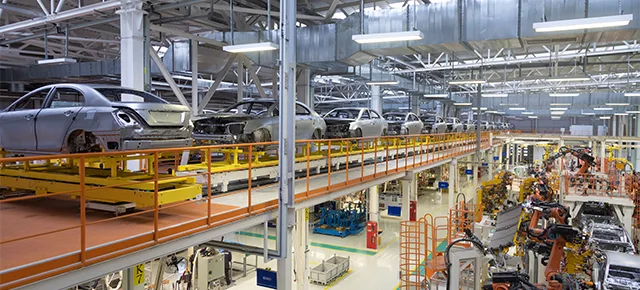Driving Efficiency: The Role of Smart Industrial Lighting in Automobile Manufacturing & Assembly Lines
The automobile industry is a highly automated, precision-driven sector where efficiency, safety, and productivity are paramount. From the assembly line to the paint shop, welding stations, and quality control areas, optimal lighting is essential to ensure smooth operations, worker well-being, and product quality.
Traditional lighting solutions are no longer sufficient to meet the demands of modern automobile manufacturing. Smart industrial lighting, powered by LED technology, IoT integration, and AI-driven automation, is transforming how automobile plants operate by enhancing efficiency, energy savings, and visibility while reducing maintenance and operational costs.
In this blog, we explore the role of smart lighting in automobile manufacturing and assembly lines, its benefits, and the latest technological advancements shaping the industry.
The Importance of Industrial Lighting in Automobile Manufacturing
1. Enhanced Visibility for Precision Work
Automobile manufacturing involves complex assembly processes, including welding, painting, and component integration. Proper lighting is crucial to ensure:
- High accuracy in manual and robotic operations
- Defect detection in quality control checks
- Minimized errors in wiring, bolting, and final assembly
2. Workplace Safety & Compliance
Poor lighting conditions can result in workplace accidents, eye strain, and fatigue. Many studies and reports suggest that inadequate lighting is a major contributor to industrial accidents. Smart lighting systems can:
- Provide uniform illumination to eliminate dark spots and glare
- Reduce the risk of worker injuries in high-risk areas
- Comply with industry safety regulations for proper illumination levels
3. Energy Efficiency & Cost Reduction
Traditional fluorescent and HID (High-Intensity Discharge) lights consume significant energy and require frequent replacements. Switching to LED-based smart lighting provides:
- Significant reduction in energy consumption
- Longer lifespan and reduced maintenance costs
- Lower heat emission, reducing cooling expenses in manufacturing units
Challenges in Traditional Automobile Manufacturing Lighting
Despite the crucial role of lighting, many automobile plants still rely on outdated lighting systems that pose significant challenges:
- High Operational Costs – Traditional lights consume excessive electricity, leading to high energy bills.
- Frequent Downtime for Maintenance – Aging fixtures require constant replacements and repairs.
- Uneven Light Distribution – Shadows and flickering lights can lead to inaccuracies and defective products.
- Limited Automation & Control – Conventional lighting lacks customization and adaptability based on production requirements.
To overcome these challenges, smart industrial lighting solutions are being rapidly adopted across the industry.
The Role of Smart Industrial Lighting in Automobile Manufacturing
1. Adaptive Lighting with IoT Integration
Smart lighting systems leverage IoT connectivity to adjust brightness levels automatically based on:
- Occupancy and movement detection in different sections of the plant
- Ambient light conditions to maintain optimal illumination
- Energy consumption monitoring for cost savings
By integrating smart lighting with factory automation, manufacturers can reduce energy waste and optimize efficiency.
2. High Ambient Temperature-Resistant LEDs
Certain sections of automobile plants, such as welding areas and paint shops, require lighting that can withstand extreme temperatures. Smart LED lighting solutions:
- Maintain consistent brightness in high-heat zones
- Reduce frequent burnouts and maintenance downtime
- Enhance worker safety by improving visibility in high-temperature workspaces
3. Glare-Free, Flicker-Free Illumination
Flickering and glare from traditional lighting systems can cause worker fatigue and eye strain. Smart LEDs:
- Offer uniform brightness with anti-glare technology
- Improve worker focus and comfort, leading to higher productivity
- Minimize visual discomfort for precision tasks, such as assembling electronic components in vehicles
4. Motion-Activated & Automated Lighting Control
Factories with large workspaces and assembly lines benefit from motion sensor-based lighting, which:
- Activates only when workers or machinery are present, saving energy
- Automatically dims or turns off lights in unoccupied zones
- Provides real-time monitoring of lighting efficiency and usage
5. Integration with AI & Predictive Maintenance
Smart lighting is evolving with AI-powered analytics that:
- Predict lighting failures before they occur, preventing sudden blackouts
- Optimize lighting schedules based on machine activity and shift patterns
- Provide data-driven insights to improve energy efficiency across the plant
Benefits of Smart Lighting in Automobile Manufacturing
1. Increased Productivity & Quality Control
- Ensures better visibility for intricate assembly processes
- Reduces errors and defects in production
- Supports real-time quality inspection with enhanced illumination
2. Significant Cost Savings
- Lower energy bills due to automated dimming and motion sensors
- Reduced maintenance costs with longer-lasting LEDs
- Fewer disruptions from frequent lighting failures
3. Improved Worker Safety & Comfort
- Enhances visual clarity in hazardous work environments
- Reduces accident risks in dark or shadowed areas
- Provides stable, flicker-free lighting to prevent fatigue
4. Sustainable & Eco-Friendly Operations
- LED-based lighting reduces carbon footprint
- Minimizes heat emissions, leading to a cooler work environment
- Supports green manufacturing initiatives in the auto sector
Future Trends: Smart Lighting Innovations for Auto Plants
1. AI-Driven Smart Lighting Networks
- Fully automated AI-based lighting grids that adjust in real time
- Machine learning algorithms optimize light intensity based on work schedules
2. Human-Centric Lighting for Shift Workers
- Adaptive lighting that mimics natural daylight to reduce fatigue
- Enhances focus and productivity for night shift workers
3. Integration with Smart Grids & Renewable Energy
- Auto plants integrating solar-powered LED systems
- Smart grids that distribute electricity based on peak production hours
Final Thoughts
Smart industrial lighting is no longer a luxury—it is a necessity for modern automobile manufacturing. By adopting IoT-enabled, AI-powered, and adaptive LED solutions, manufacturers can achieve higher efficiency, improved safety, and significant cost savings.
As the automobile industry continues to evolve towards automation, sustainability, and precision engineering, smart lighting solutions will play a critical role in shaping the future of manufacturing.
Are you ready to transform your automobile plant with intelligent lighting solutions? Contact us to know more about our cutting-edge industrial lighting solutions and take a step toward a brighter, smarter, and more efficient future.










